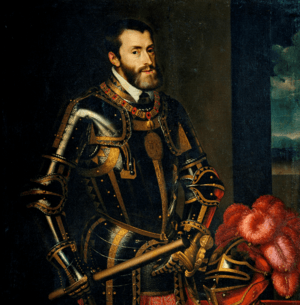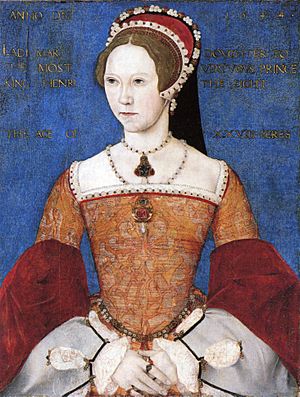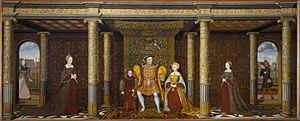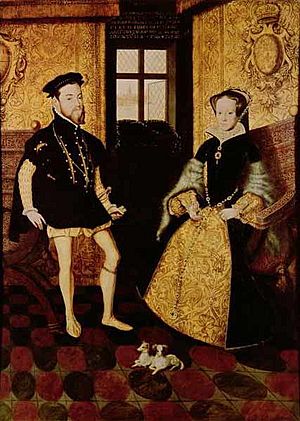Mary I of England facts for kids
Quick facts for kids Mary I |
|
|---|---|
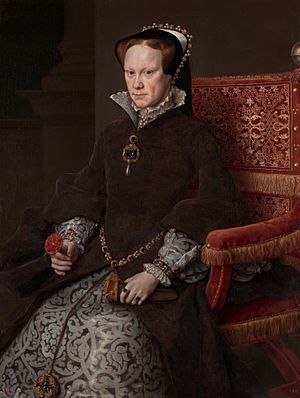
Portrait by Antonis Mor, 1554
|
|
| Queen of England and Ireland (more...) | |
| Reign | July 1553 – 17 November 1558 |
| Coronation | 1 October 1553 |
| Predecessor | Jane (disputed) or Edward VI |
| Successor | Elizabeth I |
| Co-monarch | Philip (1554–1558) |
| Queen consort of Spain | |
| Tenure | 16 January 1556 – 17 November 1558 |
| Born | 18 February 1516 Palace of Placentia, Greenwich, England |
| Died | 17 November 1558 (aged 42) St James's Palace, London, England |
| Burial | 14 December 1558 Westminster Abbey, London |
| Spouse | |
| House | Tudor |
| Father | Henry VIII |
| Mother | Catherine of Aragon |
| Religion | Roman Catholicism |
| Signature | |
Mary I (born 18 February 1516 – died 17 November 1558), also known as Mary Tudor, was the Queen of England and Ireland from July 1553. She also became Queen of Spain in January 1556 when she married King Philip II. She ruled until her death in 1558.
Mary is famous for trying to bring back the Roman Catholic faith to England. Her father, Henry VIII, had started the English Reformation, which changed England's religion. Mary tried to return church property that had been taken. But the Parliament stopped most of her efforts. During her five years as queen, Mary had over 280 people executed for their religious beliefs. Many of these people were Protestants. This led to her nickname, "Bloody Mary".
Mary was the only child of King Henry VIII and his first wife, Catherine of Aragon, to live to be an adult. Her younger half-brother, Edward VI, became king after their father died in 1547. Edward was only nine years old. In 1553, Edward became very sick. He tried to remove Mary from the line of succession. He knew she would try to reverse the Protestant changes he had made.
After Edward's death, some powerful people tried to make Lady Jane Grey queen. But Mary quickly gathered an army and took the throne. Lady Jane Grey was later executed. Mary was the first queen regnant (a queen who rules in her own right) of England. In July 1554, Mary married Prince Philip of Spain. She became queen consort of Habsburg Spain when he became king in 1556. After Mary died in 1558, her younger half-sister, Elizabeth I, became queen. Elizabeth then reversed Mary's changes and brought Protestantism back to England.
Contents
Early Life and Family
Mary was born on 18 February 1516 at the Palace of Placentia in Greenwich. She was the only child of King Henry VIII and his first wife, Catherine of Aragon, to survive past infancy. Her mother had several miscarriages and stillbirths before Mary was born.
Mary was baptized as a Catholic. Her godparents included important people like Thomas Wolsey. The Countess of Salisbury was Mary's governess (a teacher and caretaker) from 1520.
Mary's Childhood and Education
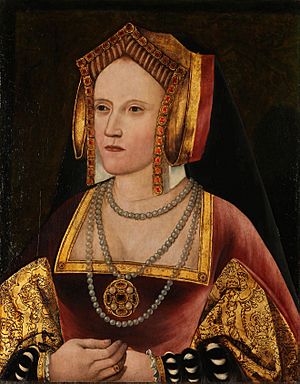
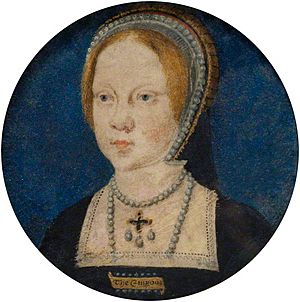
Mary was a very smart child. When she was only four years old, she played the virginals (a type of harpsichord) for French visitors. Her mother, Catherine, helped a lot with her early education. Catherine asked a Spanish scholar, Juan Luis Vives, for advice on how to educate girls. By age nine, Mary could read and write Latin. She also studied French, Spanish, music, and dance.
King Henry VIII loved his daughter very much. But he was disappointed that he did not have a son. By the time Mary was nine, it was clear that Henry and Catherine would not have more children. This meant Henry had no male heir. In 1525, Henry sent Mary to Wales. She was given her own court and many powers usually given to a Prince of Wales. She spent about three years there before returning to London in 1528.
Marriage Plans and Challenges
Throughout Mary's childhood, Henry VIII tried to arrange marriages for her. When she was two, she was promised to the son of the French king. But this agreement was later canceled. In 1522, at age six, she was promised to her 22-year-old cousin, Charles V, Holy Roman Emperor. However, Charles also broke off this engagement. Henry's chief adviser, Thomas Wolsey, then tried to arrange a marriage with the French king or his son.
By 1528, Mary was growing into a pretty young lady. But her parents' marriage was in trouble. Henry wanted to end his marriage to Catherine because she had not given him a son. He wanted to marry Anne Boleyn. The Pope refused to annul (cancel) Henry's marriage to Catherine. Henry then declared himself the head of the Church of England, not the Pope.
In 1533, Henry married Anne Boleyn. He declared his marriage to Catherine void. Mary was then considered illegitimate (not born to married parents). She was called "The Lady Mary" instead of Princess. Her place in line to the throne went to Henry and Anne's new daughter, Elizabeth. Mary's household was closed, and she was sent to live with baby Elizabeth.
Mary refused to accept Anne as queen or Elizabeth as a princess. This made King Henry very angry. Mary was often sick during this time. She was not allowed to see her mother, Catherine, who was living away from court. When Catherine died in 1536, Mary was very sad.
Mary's Adulthood and Return to Court
In 1536, Anne Boleyn was executed. Elizabeth, like Mary, was then declared illegitimate. Henry soon married Jane Seymour. Jane encouraged Henry to make peace with Mary. Henry insisted that Mary accept him as the head of the Church of England. She also had to agree that her parents' marriage was unlawful. Mary eventually signed a document agreeing to his demands.
After this, Mary returned to court. Henry gave her a household and brought back her favorite attendant, Susan Clarencieux. Mary lived in several royal palaces. She enjoyed fine clothes and playing cards. Some rebels in northern England, in an event called the Pilgrimage of Grace, wanted Mary to be made legitimate. But Mary was not involved in this rebellion, which was put down harshly. In 1537, Queen Jane died after giving birth to a son, Edward. Mary became Edward's godmother and was the chief mourner at Jane's funeral.
Mary was considered for marriage to Philip, Duke of Bavaria, but he was a Protestant, so it did not happen. In 1541, Mary's old governess, the Countess of Salisbury, was executed. This was part of a plot against Henry. In 1543, Henry married his sixth wife, Catherine Parr. She helped bring the family closer. Henry then put Mary and Elizabeth back in the line of succession in 1544. But they were still legally considered illegitimate.
Henry VIII died in 1547, and Edward became king. Edward was a child, so Protestant leaders ruled for him. They tried to make England fully Protestant. For example, a new prayer book was introduced. But Mary remained a strong Catholic. She continued to practice her faith in her own chapel. She asked her cousin, Emperor Charles V, to help her keep her religion.
Mary mostly stayed on her own estates during Edward's reign. She rarely went to court. There were plans to help her escape England, but they failed. Mary and Edward often argued about religion. Edward wanted her to give up Catholicism, but she refused.
Becoming Queen

On 6 July 1553, Edward VI died at age 15 from a lung infection. He did not want Mary to be queen because he feared she would bring back Catholicism. So, he tried to remove her and Elizabeth from the line of succession in his will.
Edward named Lady Jane Grey as his successor. Lady Jane was the granddaughter of Henry VIII's younger sister. Mary was warned that she would be captured if she went to London. So, she fled to East Anglia, where she had many supporters. Many Catholics lived there and opposed the powerful John Dudley, 1st Duke of Northumberland, who supported Jane.
On 9 July, Mary wrote to the council, demanding to be proclaimed queen. On 10 July, Lady Jane was proclaimed queen by Northumberland. But Mary quickly gathered a military force at Framlingham Castle. Northumberland's support fell apart, and Jane was removed from the throne on 19 July. Jane and Northumberland were sent to the Tower of London. Mary rode into London on 3 August 1553, with huge public support. Her half-sister Elizabeth and many nobles joined her procession.
Mary's Reign as Queen
One of Mary's first acts as queen was to free Catholic leaders from the Tower of London. She understood that Lady Jane was just a pawn in Northumberland's plan. Northumberland was executed for treason. Lady Jane and her husband were kept in the Tower. Mary appointed Stephen Gardiner as her Lord Chancellor. On 1 October 1553, Gardiner crowned Mary at Westminster Abbey.
Marriage to Philip of Spain
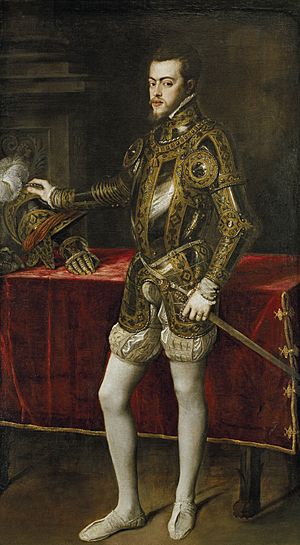
Mary was 37 and wanted to find a husband and have a child. This would prevent the Protestant Elizabeth from becoming queen. Her cousin, Emperor Charles V, suggested she marry his son, Prince Philip of Spain. Philip was heir to many lands in Europe and the New World.
Many English people did not like the idea of Mary marrying a foreigner. They feared England would become a part of the Spanish Habsburg empire. When Mary insisted on marrying Philip, rebellions broke out. Thomas Wyatt the Younger led a rebellion to replace Mary with Elizabeth. Mary publicly promised to discuss the marriage with Parliament. Wyatt's rebellion failed, and he was captured. Wyatt, Lady Jane, and her husband were executed. Elizabeth was imprisoned for a time but later released.
Mary was England's first queen who ruled in her own right. English law meant that a woman's property and titles usually became her husband's when she married. People feared Philip would become King of England in full power. But Mary's marriage treaty protected England. Philip was called "King of England" for Mary's lifetime only. He could not act without Mary's consent or appoint foreigners to English offices. Philip agreed to these terms for political reasons. He became King of Naples and titular King of Jerusalem when he married Mary. Their wedding was on 25 July 1554 at Winchester Cathedral. Philip could not speak English, so they spoke in Spanish, French, and Latin.
False Pregnancy and Disappointment
In September 1554, Mary gained weight and felt sick in the mornings. Her court and doctors believed she was pregnant. Parliament even passed a law making Philip regent if Mary died in childbirth. Elizabeth was released from house arrest to be a witness to the birth.
False rumors spread that Mary had given birth to a son. But as months passed, there was no baby. Mary continued to show signs of pregnancy until July 1555, when her abdomen returned to normal. This was likely a false pregnancy, caused by her strong desire for a child. In August, Philip left England to fight France. Mary was very sad and fell into a deep depression. She was "extraordinarily in love" with her husband.
Philip was worried that if Mary had no children, the next heir after Elizabeth would be Mary, Queen of Scots. Mary, Queen of Scots, was engaged to the French prince. Philip wanted Elizabeth to marry his cousin to secure a Catholic succession. But Elizabeth refused.
Religious Changes and Persecutions
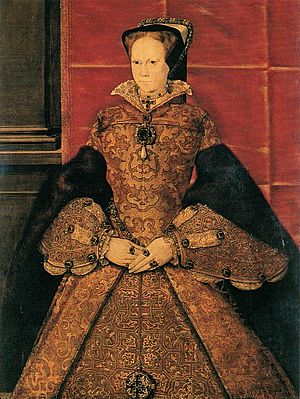
Soon after becoming queen, Mary said she would not force anyone to follow her religion. But by September 1553, many Protestant church leaders were imprisoned. Mary's first Parliament declared her parents' marriage valid. It also canceled Edward's Protestant laws. Church teachings returned to how they were under Henry VIII, which included priests not marrying. Married priests lost their positions.
Mary wanted to undo the break with Rome that her father had started. Philip helped persuade Parliament to cancel Henry's religious laws. This brought the English church back under the Pope's authority. This took many months. Mary and the Pope had to agree that lands taken from monasteries would not be returned to the church. These lands were now owned by powerful people. By late 1554, the Pope approved the deal, and laws against heresy (beliefs against official church teachings) were brought back.
About 800 wealthy Protestants fled England. Those who stayed and continued to speak about their beliefs were targeted by the heresy laws. The first executions happened in February 1555. In total, 283 people were executed, most by burning. These burnings were very unpopular. Even some of Philip's own advisers warned against them. But Mary continued the policy until her death. This made many English people dislike Catholics and the Spanish. The victims were seen as martyrs.
Foreign Policy and Challenges
Under Mary and Philip's rule, English settlers moved to the Irish Midlands. New counties were created, named Queen's County (now County Laois) and King's County (now County Offaly). Their main towns were named Maryborough and Philipstown.
In 1556, Philip's father gave up his throne. Philip became King of Spain. Philip tried to make peace with France. But in 1557, a plot against Mary was discovered. A distant cousin of the Duke of Northumberland tried to gather an invasion force in France.
Philip returned to England in 1557 to convince Mary to join Spain in a war against France. Mary wanted to declare war. But her advisers were against it. They feared it would hurt trade and that England did not have enough money or supplies. War was declared in June 1557. This happened after Thomas Stafford, a rebel, invaded England with French help.
As a result of the war, relations between England and the Pope became difficult. In August, English forces won a battle against the French. But in January 1558, French forces took Calais. This was England's last possession on the European mainland. Losing Calais was a huge blow to Mary's reputation. It is said that Mary later lamented, "When I am dead and opened, you shall find 'Calais' lying in my heart."
Trade and Money

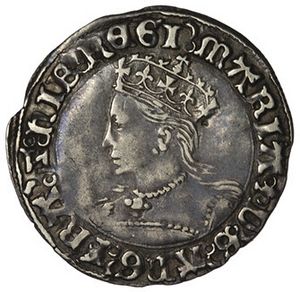
The weather during Mary's reign was very wet, leading to floods and famine. Trade also declined. England did not benefit from Spain's rich trade with the New World. The Spanish protected their trade routes closely.
Mary's advisers tried to find new trade opportunities. She gave a royal charter to the Muscovy Company to trade with Russia. She also ordered a world map from Diogo Homem. Explorers tried to develop trade with Africa.
England's money had been devalued under Henry VIII and Edward VI. Mary planned to reform the currency, but these plans were not carried out until after her death.
Death and Legacy
After Philip's visit in 1557, Mary again thought she was pregnant. She expected a baby in March 1558. She wrote in her will that Philip would rule if their child was a minor. But no child was born. Mary had to accept that her half-sister Elizabeth would be her heir.
Mary became weak and ill in May 1558. She was in pain, possibly from ovarian cysts or uterine cancer. She died on 17 November 1558, at age 42, at St James's Palace. An influenza epidemic was happening at the time. Reginald Pole, her chief religious adviser, also died that day. Elizabeth succeeded her as queen.
Mary wanted to be buried next to her mother. But she was buried in Westminster Abbey on 14 December. She shares a tomb with Elizabeth. The inscription on their tomb says, "Consorts in realm and tomb, we sisters Elizabeth and Mary here lie down to sleep in hope of the resurrection."
Mary's Impact and Reputation
John White, a bishop, praised Mary at her funeral. He said she was a king's daughter, sister, and wife, and a queen who ruled. She was the first woman to successfully claim the English throne. She had popular support at the start of her reign, especially from Catholics.
Protestant writers often criticized Mary's reign. By the 1600s, her religious persecutions led to her nickname "Bloody Mary." John Foxe strongly attacked her in his book Actes and Monuments. This book was very popular and shaped how people saw Mary as a cruel ruler. Some historians note that descriptions of Mary often had unfair ideas about women.
In the 21st century, Mary is remembered for her strong efforts to bring back Catholicism to England. Historians have started to look at her reign differently. Some scholars now see her as less intolerant than previously thought. Historian Christopher Haigh argued that her revival of religious festivals was generally welcomed. He believed her last years were a time of strengthening Catholic power. English Catholics often remembered Mary positively.
Catholic historians believe Mary's policies failed because her reign was too short. Also, natural disasters like bad harvests were beyond her control. Her marriage to Philip was unpopular. Her religious policies caused deep anger. Losing Calais to France was a big humiliation. Philip spent most of his time away, which made Mary sad. After Mary's death, Philip tried to marry Elizabeth, but she refused.
Even though Mary's rule was difficult, some good things started during her reign. These included financial reforms, expanding the navy, and exploring new lands. These were later seen as achievements of Elizabeth's reign.
Titles and Symbols

When Mary became queen, her official title was "Mary, by the Grace of God, Queen of England, France and Ireland, Defender of the Faith, and of the Church of England and of Ireland on Earth Supreme Head." Mary did not like the title "Supreme Head of the Church" because she was Catholic. So, she stopped using it after Christmas 1553.
After her marriage to Philip, their joint title included both their lands and claims. It was "Philip and Mary, by the Grace of God, King and Queen of England, Spain, France, both the Sicilies, Jerusalem and Ireland, Defenders of the Faith, Archdukes of Austria, Dukes of Burgundy, Milan and Brabant, Counts of Habsburg, Flanders and Tyrol."
Mary I's coat of arms was the same as previous English monarchs. It showed three golden fleurs-de-lys for France and three golden lions for England. Sometimes, her arms were shown next to Philip's. Her personal motto was "Truth, the Daughter of Time" (Latin: Veritas Temporis Filia).
Family Tree
Both Mary and Philip were related through John of Gaunt. This connection was used to show Philip as an English king.
| Family of Mary I of England | ||||||||||||||||||||||||||||||||||||||||||||||||||||||||||||||||||||||||||||||||||||||||||||||||||||||||||||||||||||||||||||||||||||||||||||||||||||||||||||||||||||||||||||||||||||||||||||||||||||||||||||||||||||||||||||||||||||||||||||||||||||||||||||||||||||||||||||||||||||||||||||||||||||||||||||||||||||||||||||||||||||||||||||||||||||||||||||||||||||||||||||||||||||||||||||||||||||||||||||||||||||||||||||||||||||||||||||||||||||||||||||||||||||||||||||||||||||||||||||||||||||||||||||||||||||||||||||||||||||||||||||||||||||||||||||||||||||||||||||||||||||||||||||||||||||||||||||||||||||||||||||||||||||||||||||||||||||||||||||||||||||||||||||||||||||||||||||||||||||||||||||||||||||||||||||||||||||||||||||||||||||||||||||||||||||||||||||||||||||||||||||||||||||||||||||||||||||||||||||||||||||||||||||||||||||||||||||||||||||||||||||||||||||||||||||||||||||||||||||||||||||||||||||||||||||||||||||||||||||||||||||||||||||||||||||||||||||||||||||
|---|---|---|---|---|---|---|---|---|---|---|---|---|---|---|---|---|---|---|---|---|---|---|---|---|---|---|---|---|---|---|---|---|---|---|---|---|---|---|---|---|---|---|---|---|---|---|---|---|---|---|---|---|---|---|---|---|---|---|---|---|---|---|---|---|---|---|---|---|---|---|---|---|---|---|---|---|---|---|---|---|---|---|---|---|---|---|---|---|---|---|---|---|---|---|---|---|---|---|---|---|---|---|---|---|---|---|---|---|---|---|---|---|---|---|---|---|---|---|---|---|---|---|---|---|---|---|---|---|---|---|---|---|---|---|---|---|---|---|---|---|---|---|---|---|---|---|---|---|---|---|---|---|---|---|---|---|---|---|---|---|---|---|---|---|---|---|---|---|---|---|---|---|---|---|---|---|---|---|---|---|---|---|---|---|---|---|---|---|---|---|---|---|---|---|---|---|---|---|---|---|---|---|---|---|---|---|---|---|---|---|---|---|---|---|---|---|---|---|---|---|---|---|---|---|---|---|---|---|---|---|---|---|---|---|---|---|---|---|---|---|---|---|---|---|---|---|---|---|---|---|---|---|---|---|---|---|---|---|---|---|---|---|---|---|---|---|---|---|---|---|---|---|---|---|---|---|---|---|---|---|---|---|---|---|---|---|---|---|---|---|---|---|---|---|---|---|---|---|---|---|---|---|---|---|---|---|---|---|---|---|---|---|---|---|---|---|---|---|---|---|---|---|---|---|---|---|---|---|---|---|---|---|---|---|---|---|---|---|---|---|---|---|---|---|---|---|---|---|---|---|---|---|---|---|---|---|---|---|---|---|---|---|---|---|---|---|---|---|---|---|---|---|---|---|---|---|---|---|---|---|---|---|---|---|---|---|---|---|---|---|---|---|---|---|---|---|---|---|---|---|---|---|---|---|---|---|---|---|---|---|---|---|---|---|---|---|---|---|---|---|---|---|---|---|---|---|---|---|---|---|---|---|---|---|---|---|---|---|---|---|---|---|---|---|---|---|---|---|---|---|---|---|---|---|---|---|---|---|---|---|---|---|---|---|---|---|---|---|---|---|---|---|---|---|---|---|---|---|---|---|---|---|---|---|---|---|---|---|---|---|---|---|---|---|---|---|---|---|---|---|---|---|---|---|---|---|---|---|---|---|---|---|---|---|---|---|---|---|---|---|---|---|---|---|---|---|---|---|---|---|---|---|---|---|---|---|---|---|---|---|---|---|---|---|---|---|---|---|---|---|---|---|---|---|---|---|---|---|---|---|---|---|---|---|---|---|---|---|---|---|---|---|---|---|---|---|---|---|---|---|---|---|---|---|---|---|---|---|---|---|---|---|---|---|---|---|---|---|---|---|---|---|---|---|---|---|---|---|---|---|---|---|---|---|---|---|---|---|---|---|---|---|---|---|---|---|---|---|---|---|---|---|---|---|---|---|---|---|---|---|---|---|---|---|---|---|---|---|---|---|---|---|---|---|---|---|---|---|---|---|---|---|---|---|---|---|---|---|---|---|---|---|---|---|---|---|---|---|---|---|---|---|---|---|---|---|---|---|---|---|---|---|---|---|---|---|---|---|---|---|---|---|---|---|---|---|---|---|---|---|---|---|---|---|---|---|---|---|---|---|---|---|---|---|---|---|---|---|---|---|---|---|---|---|---|---|---|---|---|---|---|---|---|---|---|---|---|---|---|---|---|---|---|---|---|---|---|---|---|---|---|---|---|---|---|---|---|---|---|---|---|---|---|---|---|---|---|---|---|---|---|---|---|---|---|---|---|---|---|---|---|---|---|---|---|---|---|---|---|---|---|---|---|---|---|---|---|---|---|---|---|---|---|---|---|---|---|---|---|---|---|---|---|---|---|---|---|---|---|---|---|---|---|---|---|---|---|---|---|---|---|---|---|---|---|---|---|---|---|---|---|---|---|---|---|---|---|---|---|---|---|---|---|---|---|---|---|---|---|---|---|---|---|---|---|---|---|---|---|---|---|---|---|---|---|---|---|---|---|---|---|---|---|---|---|---|---|---|---|---|---|---|---|---|---|---|---|---|---|---|---|---|---|---|---|---|---|---|---|---|---|---|---|---|---|---|---|---|---|---|---|---|---|---|---|---|---|---|---|---|---|---|---|---|---|---|---|---|---|---|---|---|---|---|---|---|
|
||||||||||||||||||||||||||||||||||||||||||||||||||||||||||||||||||||||||||||||||||||||||||||||||||||||||||||||||||||||||||||||||||||||||||||||||||||||||||||||||||||||||||||||||||||||||||||||||||||||||||||||||||||||||||||||||||||||||||||||||||||||||||||||||||||||||||||||||||||||||||||||||||||||||||||||||||||||||||||||||||||||||||||||||||||||||||||||||||||||||||||||||||||||||||||||||||||||||||||||||||||||||||||||||||||||||||||||||||||||||||||||||||||||||||||||||||||||||||||||||||||||||||||||||||||||||||||||||||||||||||||||||||||||||||||||||||||||||||||||||||||||||||||||||||||||||||||||||||||||||||||||||||||||||||||||||||||||||||||||||||||||||||||||||||||||||||||||||||||||||||||||||||||||||||||||||||||||||||||||||||||||||||||||||||||||||||||||||||||||||||||||||||||||||||||||||||||||||||||||||||||||||||||||||||||||||||||||||||||||||||||||||||||||||||||||||||||||||||||||||||||||||||||||||||||||||||||||||||||||||||||||||||||||||||||||||||||||||||||
See also
 In Spanish: María I de Inglaterra para niños
In Spanish: María I de Inglaterra para niños


